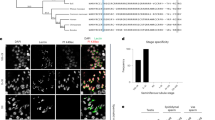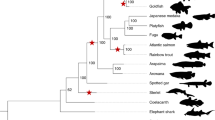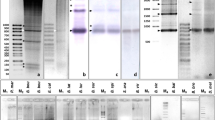Abstract
SPERMATOGENESIS in the rainbow trout (Salmo gairdnerii) is associated with the Onset of synthesis of the protamines1,2, a family of small, highly basic proteins consisting of 32 or 33 residues, of which approximately two-thirds are arginine3. By displacing the histones, the protamines have a unique role in packaging sperm DNA. The biosynthesis of the protamines has been studied in some detail, and polyadenylated protamine mRNA of about 290 nucleotides has been isolated from trout testis4,5 and shown by R0t analysis to be made up of three to four components5,6. More recent work suggests that there are about six different protamine genes per haploid genome7. In contrast to the interspecific conservation of histone sequences, the observed rate of protamine sequence divergence between the closely related clupeid fishes such as trout, salmon and herring, is very high, and there is evidence that protamine genes have arisen following a doubling of the ancestral fish genome. Comparison of the cloned complementary DNA sequences and ultimately of the genes themselves will help to elucidate the molecular events involved in the evolution of these proteins. To study the chromosomal organisation of these genes and the control of their expression during spermatogenesis, I have constructed cDNA clones using purified poly(A)+ mRNA as starting material. Here, the sequences of three of these recombinants are compared, revealing an unexpected pattern of divergence in the coding and non-coding regions, as well as a mutational ‘hot-spot’ corresponding to the major phosphorylation site of the protamines.
This is a preview of subscription content, access via your institution
Access options
Subscribe to this journal
Receive 51 print issues and online access
$199.00 per year
only $3.90 per issue
Buy this article
- Purchase on Springer Link
- Instant access to full article PDF
Prices may be subject to local taxes which are calculated during checkout
Similar content being viewed by others
References
Marushige, K. & Dixon, G. H. Devl Biol. 19, 397–414 (1969).
Marushige, K. & Dixon, G. H. J. biol. Chem. 246, 5799–5805 (1971).
Ando, T. & Watanabe, S. Int. J. Protein Res. 1, 221–224 (1969).
Gedamu, L. & Dixon, G. H. J. biol. Chem. 251, 1455–1463 (1976).
Jenkins, J. R., Bishop, J. O. & Butterworth, P. H. W. (in preparation).
Iatrou, K. & Dixon, G. H. Cell 10, 433–441 (1977).
Sakai, M., Fuji-Kuriyama, Y. & Muramatsu, M. Biochemistry 17, 5510–5515 (1978).
Maxam, A. M. & Gilbert, W. Proc. natn. Acad. Sci. U.S.A. 74, 560–564 (1977).
Proudfoot, N. J. & Brownlee, G. G. Nature 263, 211–214 (1976).
Ferrier, L. N., Davies, P. L. & Dixon, G. H. Biochim. biophys. Acta 479, 460–470 (1977).
Poon, R., Yuet, W. K. & Boyer, H. W. Nucleic Acids Res. 5, 4625–4630 (1978).
Salser, W. Cold Spring Harb. Symp. quant. Biol. 42, 985–1002 (1977).
Kafatos, F. C., Efstratiadis, A., Forget, B. A. & Weissman, S. Proc. natn. Acad. Sci. U.S.A. 74, 5618–5622 (1977).
Ohno, S. & Atkin, N. B. Chromosoma 18, 455–466 (1966).
Bailey, G. S., Cox, G. T. & Wilson, A. C. Biochem biophys. Res. Commun. 34, 605–612 (1969).
Ohno, S. Monographs on Endocrinology Vol. 1, 63–64 (Springer, New York, 1967).
Ling, V., Jergil, B. & Dixon, G. H. J. biol. Chem. 246, 1168–1176 (1971).
Karkel, D. A., Tilghman, S. M. & Leder, P. Cell 15, 1125–1132 (1978).
Marotta, C. A., Wilson, J. T., Forget, B. A. & Weissman, S. M. J. biol. Chem. 252, 5040–5059 (1977).
Ando, T. & Suzuki, K. Biochim. biophys. Acta 140, 375–377 (1967).
Ando, T. & Suzuki, K. Biochim. biophys. Acta 121, 427–429 (1966).
Sanders, M. M. & Dixon, G. H. J. biol. Chem. 247, 851–855 (1972).
Dixon, G. H. Karolinska 5th Symposium on Research Methods in Reproductive Endocrinology, 130–154 (1972).
Davies, P. L., Ferrier, L. N. & Dixon, G. H. J. biol. Chem. 252, 1386–1393 (1977).
Setlow, P. in Handbook of Biochemistry and Molecular Biology—Nucleic Acids Vol. 2 (ed. Fasman, G. D.) 312–318 (CRC Press, Cleveland, Ohio, 1976).
Fraser, N. W., Burden, R. H. & Elton, R. A. Nucleic Acids Res. 2, 2131–2146 (1975).
Roy, P. H. & Weissbach, A. Nucleic Acids Res. 2, 1669–1684 (1975).
Coulondre, C., Miller, J. H., Farabaugh, P. J. & Gilbert, W. Nature 274, 775–780 (1978).
Author information
Authors and Affiliations
Rights and permissions
About this article
Cite this article
JENKINS, J. Sequence divergence of rainbow trout protamine mRNAs; comparison of coding and non-coding nucleotide sequences in three protamine cDNA plasmids. Nature 279, 809–811 (1979). https://doi.org/10.1038/279809a0
Received:
Accepted:
Issue Date:
DOI: https://doi.org/10.1038/279809a0
This article is cited by
-
A genetic fossil: Protamine gene as a primordial gene
Naturwissenschaften (1993)
Comments
By submitting a comment you agree to abide by our Terms and Community Guidelines. If you find something abusive or that does not comply with our terms or guidelines please flag it as inappropriate.



